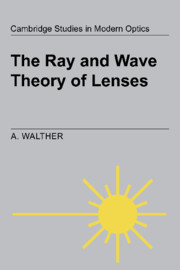Book contents
- Frontmatter
- Contents
- Preface
- Part one Preview
- Part two Geometrical optics
- Part three Paraxial optics
- Part four Waves in homogeneous media
- Part five Wave propagation through lenses
- 17 Toward a wave theory of lenses
- 18 General propagation kernels
- 19 Paraxial wave propagation
- 20 The wave theory of image formation
- 21 Fourier optics
- Part six Aberrations
- Part seven Applications
- Appendix 1 Fourier transforms
- Appendix 2 Third order calculations
- Appendix 3 Ray tracing
- Appendix 4 Eikonals and the propagation kernels
- Appendix 5 Paraxial eikonals
- Appendix 6 Hints and problem solutions
- Bibliography
- Index
17 - Toward a wave theory of lenses
Published online by Cambridge University Press: 22 September 2009
- Frontmatter
- Contents
- Preface
- Part one Preview
- Part two Geometrical optics
- Part three Paraxial optics
- Part four Waves in homogeneous media
- Part five Wave propagation through lenses
- 17 Toward a wave theory of lenses
- 18 General propagation kernels
- 19 Paraxial wave propagation
- 20 The wave theory of image formation
- 21 Fourier optics
- Part six Aberrations
- Part seven Applications
- Appendix 1 Fourier transforms
- Appendix 2 Third order calculations
- Appendix 3 Ray tracing
- Appendix 4 Eikonals and the propagation kernels
- Appendix 5 Paraxial eikonals
- Appendix 6 Hints and problem solutions
- Bibliography
- Index
Summary
Introduction
So far we have only dealt with waves in unbounded spaces. The item now on the agenda is extending the wave theory to encompass the passage of waves through lenses.
When a light wave enters a lens, it is redirected and distorted by the lens surfaces, and truncated by the diaphragm as well as by the lens edges. The calculation of the wave arriving in the image space requires, from the point of view of an uncompromising physicist, the solution of a boundary value problem so complicated that its exact solution is hopelessly intractable except for very simple cases, such as diffraction by a solid homogeneous sphere [18] or the reflection of a plane wave by the exterior of a perfectly conducting paraboloid [26]. Courageous approximations are clearly needed to arrive at a theory that can be used in the daily practice of lens design.
One simplifying feature of the problem is the linear relation between the field in the object space and the field in the image space. The field in the image space created by the sum of several input fields is the sum of the image fields created by the individual inputs. There are, of course, exceptions to this rule. Non-linear media may display frequency doubling; absorption of the input wave may cause thermal effects that change the lens characteristics, etc. Such effects can better be dealt with on a case to case basis after the linear theory is worked out in detail.
- Type
- Chapter
- Information
- The Ray and Wave Theory of Lenses , pp. 169 - 176Publisher: Cambridge University PressPrint publication year: 1995

